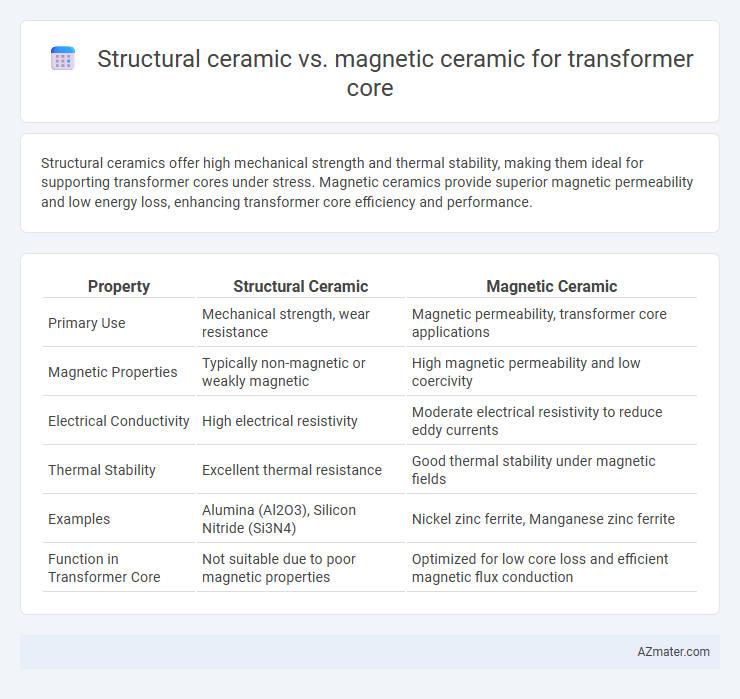Structural ceramics offer high mechanical strength and thermal stability, making them ideal for supporting transformer cores under stress. Magnetic ceramics provide superior magnetic permeability and low energy loss, enhancing transformer core efficiency and performance.
Table of Comparison
| Property | Structural Ceramic | Magnetic Ceramic |
|---|---|---|
| Primary Use | Mechanical strength, wear resistance | Magnetic permeability, transformer core applications |
| Magnetic Properties | Typically non-magnetic or weakly magnetic | High magnetic permeability and low coercivity |
| Electrical Conductivity | High electrical resistivity | Moderate electrical resistivity to reduce eddy currents |
| Thermal Stability | Excellent thermal resistance | Good thermal stability under magnetic fields |
| Examples | Alumina (Al2O3), Silicon Nitride (Si3N4) | Nickel zinc ferrite, Manganese zinc ferrite |
| Function in Transformer Core | Not suitable due to poor magnetic properties | Optimized for low core loss and efficient magnetic flux conduction |
Introduction to Ceramics in Transformer Core Applications
Structural ceramics in transformer cores offer high mechanical strength and thermal stability, making them suitable for supporting components exposed to physical stress. Magnetic ceramics, such as ferrites, provide essential magnetic properties like high permeability and low core loss, optimizing transformer efficiency and frequency response. Understanding the distinct roles of these ceramics enhances the design and performance of transformer cores in electrical applications.
Overview of Structural Ceramics
Structural ceramics used in transformer cores exhibit high mechanical strength, thermal stability, and resistance to wear and corrosion, enabling them to withstand harsh operating conditions and mechanical stresses. Unlike magnetic ceramics, which primarily focus on magnetic permeability and electrical insulation, structural ceramics provide robust support and durability without contributing significantly to magnetic properties. Common materials include alumina and silicon carbide, chosen for their exceptional hardness and thermal conductivity, optimizing transformer core longevity and reliability.
Overview of Magnetic Ceramics
Magnetic ceramics, commonly used in transformer cores, exhibit exceptional magnetic permeability and low electrical conductivity, which minimizes eddy current losses and enhances energy efficiency. These materials, such as ferrites, are engineered to maintain high magnetic saturation and thermal stability, making them ideal for high-frequency transformer applications. Their structural integrity combined with tailored magnetic properties enables improved performance and longevity in transformer cores compared to traditional structural ceramics.
Material Properties: Structural vs Magnetic Ceramics
Structural ceramics exhibit high mechanical strength, hardness, and thermal stability, making them ideal for applications demanding durability and wear resistance. Magnetic ceramics, such as ferrites, possess unique magnetic permeability and low electrical conductivity, optimizing them for efficient magnetic flux conduction and minimal eddy current losses in transformer cores. The selection between structural and magnetic ceramics for transformer cores hinges on balancing mechanical robustness with superior magnetic properties to ensure performance and longevity.
Performance Comparison in Transformer Cores
Structural ceramics exhibit high mechanical strength and thermal stability, making them suitable for transformer cores requiring durability under thermal stress. Magnetic ceramics, specifically ferrites, offer superior magnetic permeability and low core losses, enhancing transformer efficiency and minimizing eddy current losses. Comparing performance, magnetic ceramics optimize electromagnetic properties crucial for transformer operation, while structural ceramics provide mechanical support, highlighting the need for material selection based on specific transformer design priorities.
Electrical and Magnetic Characteristics
Structural ceramics used in transformer cores offer high mechanical strength and thermal stability but generally exhibit lower magnetic permeability and higher electrical resistivity, reducing core losses under high-frequency conditions. Magnetic ceramics, such as ferrites, provide superior magnetic characteristics with high permeability and low coercivity, enabling efficient magnetic flux conduction and minimal hysteresis losses. The choice between structural and magnetic ceramics depends on balancing mechanical durability with optimal magnetic performance for transformer efficiency.
Thermal Stability and Efficiency
Structural ceramics used in transformer cores exhibit superior thermal stability due to their high melting points and resistance to thermal shock, ensuring consistent performance under variable operating temperatures. Magnetic ceramics, such as ferrites, offer enhanced magnetic efficiency by minimizing eddy current losses and maintaining low core losses at high frequencies. Comparing both, magnetic ceramics strike a balance between thermal stability and magnetic permeability, optimizing transformer efficiency in applications requiring high-frequency operation.
Cost and Manufacturing Considerations
Structural ceramics for transformer cores typically exhibit higher material costs due to superior mechanical strength and thermal stability, demanding advanced manufacturing processes such as hot pressing or sintering under controlled atmospheres. Magnetic ceramics, like ferrites, offer lower cost advantages through mass production techniques, including conventional sintering at relatively lower temperatures, making them economically favorable for large-scale transformer applications. Manufacturing considerations highlight that while structural ceramics require precision tooling and longer cycle times, magnetic ceramics benefit from simpler fabrication and scalability, impacting overall production expenses and resource allocation.
Application Suitability and Industry Use Cases
Structural ceramics, known for their high mechanical strength and thermal stability, are ideal for transformer cores requiring durability in harsh environmental conditions, such as power distribution in industrial settings and high-voltage equipment. Magnetic ceramics, specifically ferrites, offer low eddy current losses and high magnetic permeability, making them suitable for high-frequency transformers in telecommunications and consumer electronics. The choice between structural and magnetic ceramics hinges on application demands, where mechanical robustness favors structural ceramics and superior magnetic properties favor magnetic ceramics in core design.
Future Trends in Ceramic Transformer Core Materials
Future trends in ceramic transformer core materials emphasize the development of magnetic ceramics with enhanced permeability and reduced core losses, driven by the need for energy-efficient transformers in renewable energy and electric vehicle applications. Structural ceramics, traditionally valued for mechanical strength and thermal stability, are increasingly integrated with magnetic properties through advanced doping and manufacturing techniques to create multifunctional transformer cores. Innovations in nano-structure engineering and ferrite compositions are expected to optimize magnetic ceramic performance, enabling smaller, lighter, and more efficient transformer cores that meet evolving power industry requirements.

Infographic: Structural ceramic vs Magnetic ceramic for Transformer core
 azmater.com
azmater.com